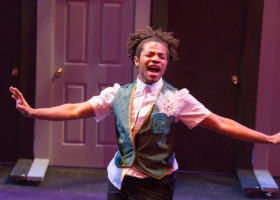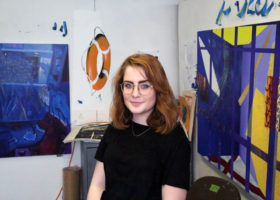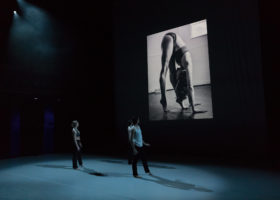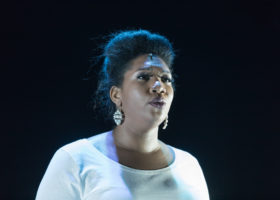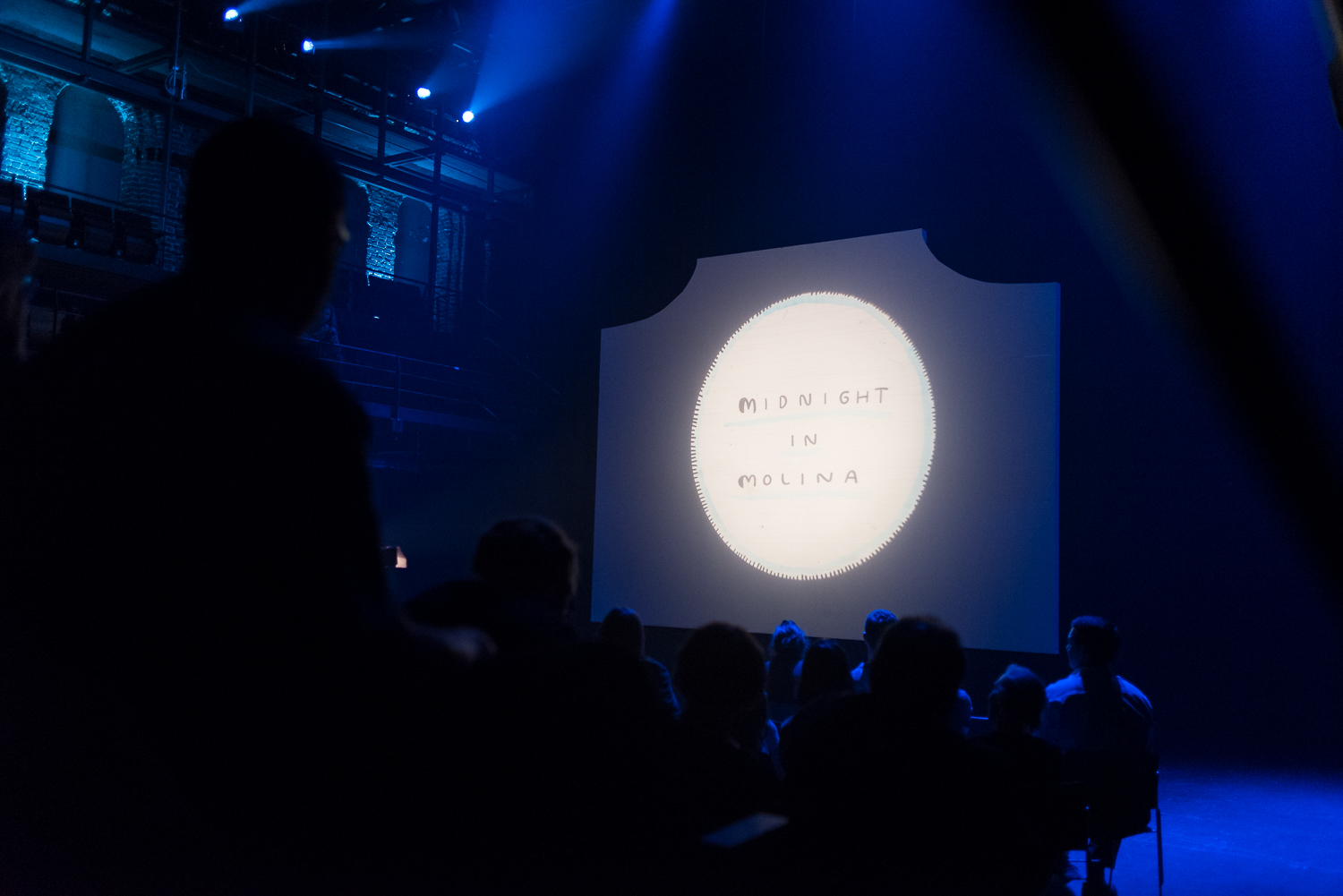
As part of The Glassblock’s sponsored partnership with the New Hazlett Theater, we are presenting a series of editorially-independent previews and reviews of the 2016-2017 Community Supported Art (CSA) Performance Series. Below is our review of Midnight in Molina by Cole Hoyer-Winfield, a collaborative response from editor Adam Shuck, arts and culture editor David Bernabo, and guest panelists Kathryn Carr and Derek Reese. Read their bios below. And read our preview of the performance here.
 Kathryn Carr. “I have focused my talents on the art of paper cutting since 2008. I’ve turned my attention towards this art form because I was drawn to the bold imagery of the paper cut silhouette and the intriguing shadows they cast. I am self-taught in this discipline and I continue to experiment with new materials and styles. My whimsical designs begin by sketching an idea and giving it a sense of movement and playfulness. I will then draw the image on the back of the paper that is to be cut. Using a scissor or knife blade I’ll carefully cut away the paper to reveal the image. A selection of my original paper cut art is digitally reproduced to make up a line of greeting cards, prints, tea towels and other fun and useful items. I am inspired by the German paper cut art Scherenschnitte and how it portrays everyday life in silhouette form.”
Kathryn Carr. “I have focused my talents on the art of paper cutting since 2008. I’ve turned my attention towards this art form because I was drawn to the bold imagery of the paper cut silhouette and the intriguing shadows they cast. I am self-taught in this discipline and I continue to experiment with new materials and styles. My whimsical designs begin by sketching an idea and giving it a sense of movement and playfulness. I will then draw the image on the back of the paper that is to be cut. Using a scissor or knife blade I’ll carefully cut away the paper to reveal the image. A selection of my original paper cut art is digitally reproduced to make up a line of greeting cards, prints, tea towels and other fun and useful items. I am inspired by the German paper cut art Scherenschnitte and how it portrays everyday life in silhouette form.”
 Derek Reese is an artist and educator who believes in the transformative power of art at an individual level and within communities. Reese’s interdisciplinary approach art making explores identity and crises through materials and imagery inspired by his Appalachian upbringing. Reese exhibits his art work regionally and nationally with recent a recent solo exhibition at the Pittsburgh Center for the Arts. Currently, Reese serves as the Director of Education and Outreach at Sweetwater Center for the Arts in Sewickley, Pennsylvania. Sweetwater’s mission is to develop impactful educational programming for individuals of all ages, backgrounds and abilities in Northern Allegheny and Beaver counties as well as curating arts-based projects with, and for, other organizations geared toward serving communities in Pittsburgh and beyond.
Derek Reese is an artist and educator who believes in the transformative power of art at an individual level and within communities. Reese’s interdisciplinary approach art making explores identity and crises through materials and imagery inspired by his Appalachian upbringing. Reese exhibits his art work regionally and nationally with recent a recent solo exhibition at the Pittsburgh Center for the Arts. Currently, Reese serves as the Director of Education and Outreach at Sweetwater Center for the Arts in Sewickley, Pennsylvania. Sweetwater’s mission is to develop impactful educational programming for individuals of all ages, backgrounds and abilities in Northern Allegheny and Beaver counties as well as curating arts-based projects with, and for, other organizations geared toward serving communities in Pittsburgh and beyond.
![]()
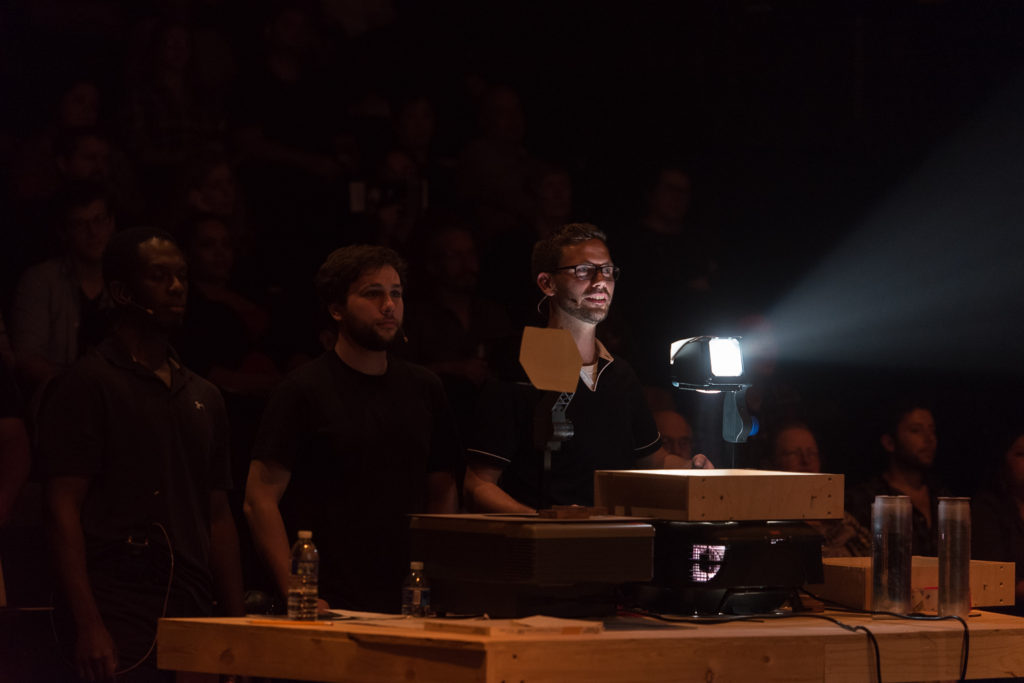
It starts with a jolt. A “wheeeee,” a “yeaaaah,” a burst of drums, keyboard, bass, and guitar; and in lightning-fast succession, an illuminated projector throws an explosion of illustrations against the screen. On October 20, Cole Hoyer-Winfield’s Midnight in Molina kicked off the first of the New Hazlett Theater’s 2016-17 CSA Performance Series. Narrated by Hoyer-Winfield himself and voice actors Christian Mocombe and Daniel Valentine, with musical accompaniment by Matt Breslof, Sam Molstad, Jeff Ryan, and Swampwalk, Midnight in Molina is a story told in two timelines using imagery from a hand-rotated crankie and an overhead projector, and within the first few minutes the audience is served all of the structural elements that will be used to construct a fantastical tale of curiosity, nostalgia and memory, and the supernatural.
In our preview of Midnight in Molina, we learned about the “crankie” and the artistic background that led Cole Hoyer-Winfield to take it up. Sure enough, the main performer is this inanimate object, a mechanistic novelty that unspools a roll of hand-drawn illustration on sheets of transparency. But as we progress through the story, we’re shown images from an accompanying instrument. While the crankie throws up a relatively smooth progression of imagery, the overhead projector presents a contrasting style, a series of static images that details the historical background of the town of Molina. These parallel—and later intersecting—storylines, which trade off as the primary storytelling voice throughout the performance, give Midnight in Molina a vital breadth and depth despite some initial abruptness of pacing.
Eugene, our main character, voiced by Hoyer-Winfield, is a travel journalist, and he prides himself in his work—especially as it allows him to travel all over the world. As the story first unfolds, we tag along with Eugene as he zips on his bike around the bustling city he lives in. His life is active and full, if not a bit stressful, and in his day-to-day he contends with a routine that verges on the monotonous, a sniping rival named Chaz, and a threatening rock that his bicycle always seems to aim for. When he is assigned to cover a festival in his hometown of Molina, it comes as a welcome respite.
While Eugene’s home base is quick-paced and active, punctuated by regular caffeine-fueling at a crowded coffee shop, Molina is laid back and familiar. Back at home, Eugene reconnects with his childhood friend Frank, who’s given a delightful Pittsburghese inflection by voice actor Daniel Valentine. Frank is a carefree townie who makes ends meet by pilfering bicycles and other items and selling them at yard sales. Molina is “exactly the same as I remember,” Eugene says to himself, but as he spends more time surveying Molina, he notices that, instead, things have changed. A mysterious recent rash of fires has razed some of Molina’s buildings, and in their place, new developments are springing up—a restaurant with the trendy name of Mouthfeel, a precious mustache barber shop. On the site of the old Molina town hall, a sexy new high-rise. Molina, a center of glass manufacturing turned sleepy post-industrial, is gentrifying.
This is one of several plot tensions explored in the early scenes of Midnight in Molina: One’s old life versus the new; analog versus digital; the tricky haze of memory versus the reality of present experience. Though none of these conflicts are particularly well developed—Hoyer-Winfield’s story nods to these opposite themes without a full unpacking of them—these tensions underpinned much of Midnight in Molina’s exposition and serve as small engines propelling the story forward.
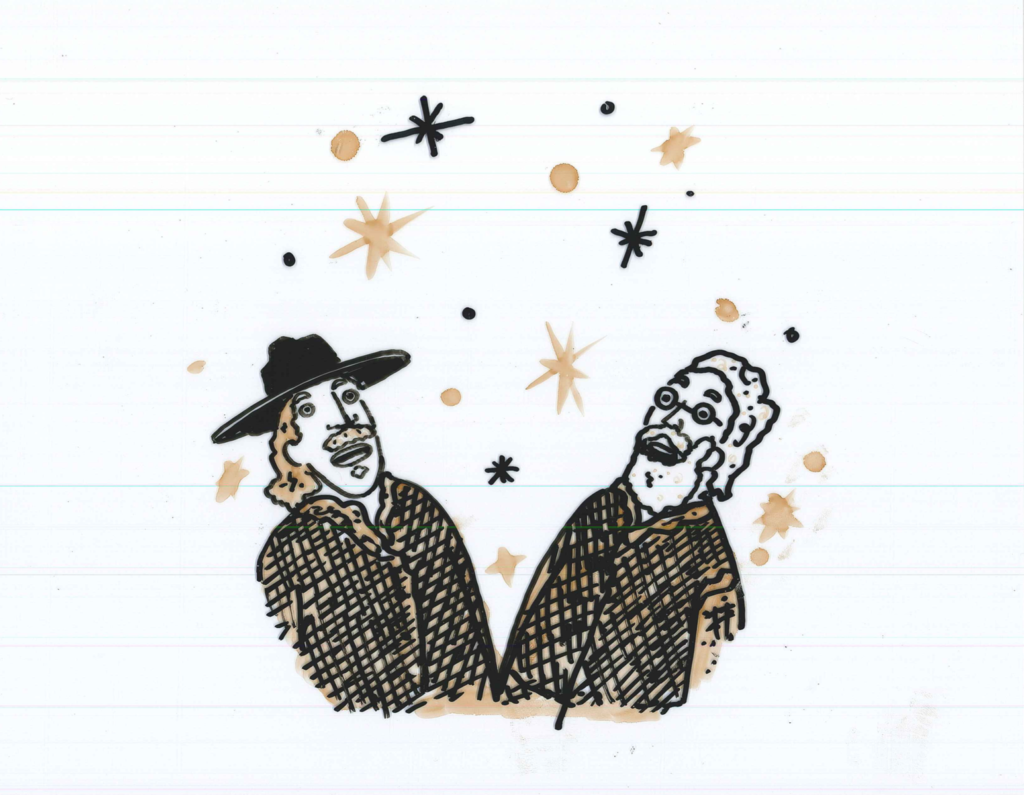 Woven in with the present-day, as depicted through Hoyer-Winfield’s crankie, is a second projection that fills us in on the past. In chaptered segments, we switch over to this second projection, narrated by Christian Mocombe, that delivers the story of the 19th century pioneers Harlow Orton and Xavier Molina, the founders of Molina. With a distinct matter-of-fact, documentarian voice, this second storyline stands in sharp contrast to Hoyer-Winfield’s storyline. Often, the story switches back and forth at specific heightened moments, leaving the audience at classic moments of cliffhanger. But with its slower pacing, the changeover from present to past sometimes felt a bit abrupt. And while the present-day story is delivered in fluid crankie motion, the historic plot is presented through static overhead projector sheets that are swapped out by hand every few seconds, which in comparison felt a bit clunky. The perfect instrument might have been an old-fashioned slide projector, on a carousel, which each slide’s advancing, registered by that satisfying mechanical click, imparting the intended sense of the nostalgic past.
Woven in with the present-day, as depicted through Hoyer-Winfield’s crankie, is a second projection that fills us in on the past. In chaptered segments, we switch over to this second projection, narrated by Christian Mocombe, that delivers the story of the 19th century pioneers Harlow Orton and Xavier Molina, the founders of Molina. With a distinct matter-of-fact, documentarian voice, this second storyline stands in sharp contrast to Hoyer-Winfield’s storyline. Often, the story switches back and forth at specific heightened moments, leaving the audience at classic moments of cliffhanger. But with its slower pacing, the changeover from present to past sometimes felt a bit abrupt. And while the present-day story is delivered in fluid crankie motion, the historic plot is presented through static overhead projector sheets that are swapped out by hand every few seconds, which in comparison felt a bit clunky. The perfect instrument might have been an old-fashioned slide projector, on a carousel, which each slide’s advancing, registered by that satisfying mechanical click, imparting the intended sense of the nostalgic past.
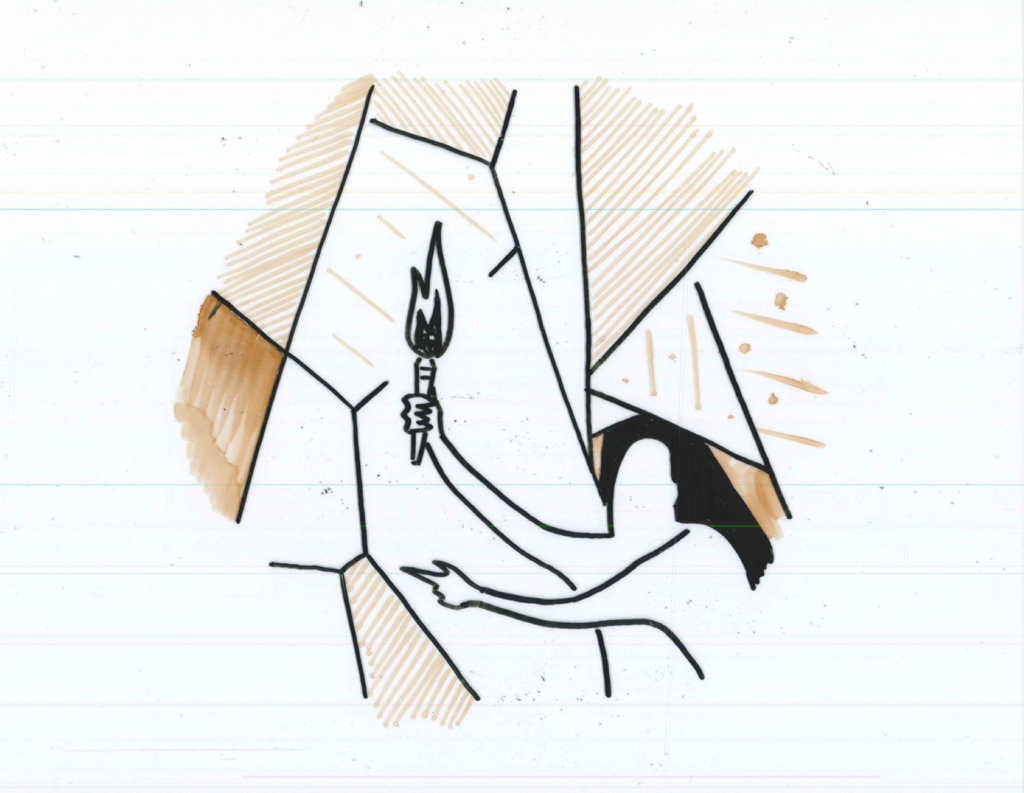 For its part, Hoyer-Winfield’s crankie had its own voice on stage, a sort of in-motion creaking that, rather than posing an unwanted distraction, was actually charming. Similarly, inked fingerprints in the projections’ margins here and there were a reminder that this was an entirely hand-crafted enterprise. Physical elements represented a strong, dominant motif in the story, in fact: Rock, water, fire, and crystal played elemental roles, and in conjunction with Midnight in Molina’s overarching spirit of nostalgia and memory, these hard, naturalistic motifs were welcome.
For its part, Hoyer-Winfield’s crankie had its own voice on stage, a sort of in-motion creaking that, rather than posing an unwanted distraction, was actually charming. Similarly, inked fingerprints in the projections’ margins here and there were a reminder that this was an entirely hand-crafted enterprise. Physical elements represented a strong, dominant motif in the story, in fact: Rock, water, fire, and crystal played elemental roles, and in conjunction with Midnight in Molina’s overarching spirit of nostalgia and memory, these hard, naturalistic motifs were welcome.
But Midnight in Molina avoided any dragging sense of over-seriousness. “It was nice to hear the audience laughing,” The Glassblock’s co-reviewer Kathrynn Carr noted, and there was a lot that was both built into the plot and extemporaneously added that was relatable, casual, and fun. In a sense, despite some of the story’s more earnest moments, it felt like a cartoon, mixing a sort of jocular looseness with a witty incisiveness. And some moments were customized to the audience at that moment. The date of the festival in Molina was said to be the very date of the performance, for example, and it was apparent that Hoyer-Winfield as Eugene and Valentine as Frank were riffing off of each other while also gauging the audience’s reactions. All of this lent the performance a vivid presentness.
Eventually, Midnight in Molina joins the two plotlines together, fusing the past with the present in a dramatic and supernatural way—equal parts Twin Peaks, Indiana Jones, and classic B-movie monster camp. Though in some sense loose ends were tied up, and cliffhangers found their natural resolutions, there was the feeling of an overall lack of consequence for any of the main characters, on an emotional level. The plot’s twists and turns pushed the story along, but the eventual outcomes didn’t lead to any change or development on the characters’ part. In a way, this echoes the feeling of a cartoon: Despite whatever zany antics, at the end of the episode, our characters return to square one, sometimes by way of a winking deus ex machina.
But this is also the experience of a dream, and in many ways Midnight in Molina operates with a kind of dream logic. There may not be a lesson learned, in a traditional character arc. Instead, the story is illustrated through vivid moments and experiences, sometimes dipping into the uncanny or a disorientation requiring suspension of disbelief, and colored by strong mystical and naturalistic motifs that linger much longer than the plot line’s specifics. Midnight in Molina projected a number of stars but didn’t necessarily connect them all into a coherent constellation. Like little eddies spinning off of an obstacle in a river’s current, the story presented us with brief, dazzling moments that, though they might not have meant much for the overall story, were crucial in the makeup of Midnight in Molina’s spirit. This also meant that there was a refreshing element of play in the performance. Avoiding overserious dramatism, Hoyer-Winfield and Valentine in particular reacted in a thoroughly natural way to the storyline. Rather than overly rehearsed and scripted, Midnight in Molina was strengthened by its “and then this happened” collaborative spirit. Like a dream, it was alive and spontaneous, and sometimes without consistent logic.
“This is a jaunt,” The Glassblock’s co-reviewer Derek Reese said in our discussion after the performance, “so I put my notebook away and just enjoyed the story.” Roll along with me, Midnight in Molina seemed to say with its protean wisps of theme; here’s an escape.
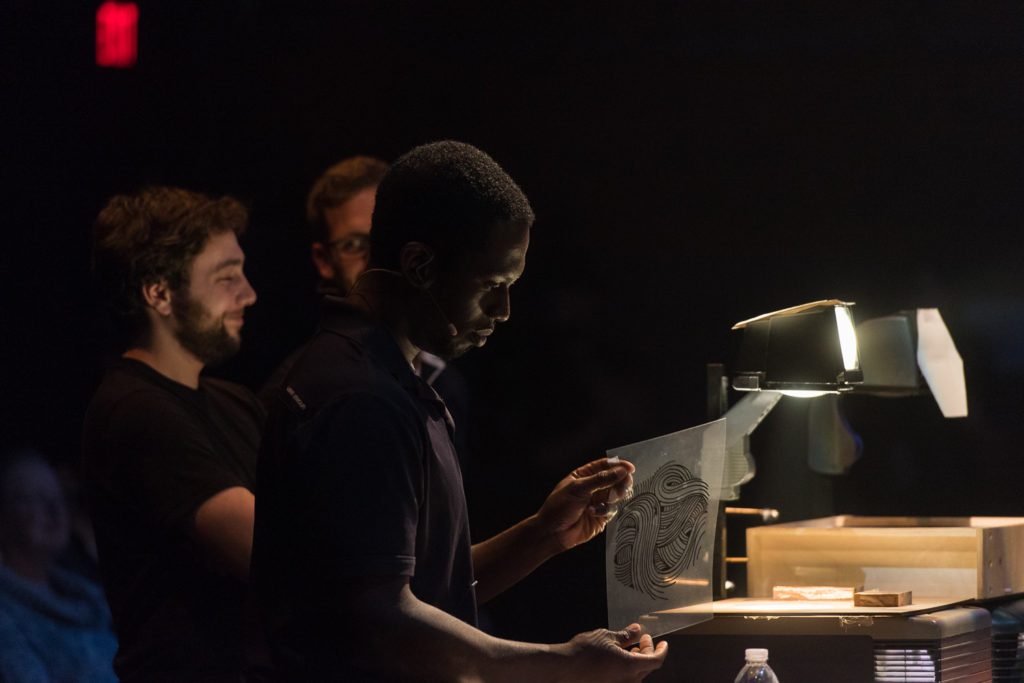
This isn’t to say that Midnight in Molina lacked depth or seriousness. Given the crankie’s scrolling sheets, or the succession of still images on the overhead projector, Hoyer-Winfield’s visual language proved effective. On the crankie, sweeping landscapes would give way to a close-up on a character’s face, eyebrow raised in an unmistakable gesture. On the overhead projector, glinting, faceted crystals in a cavernous underground chamber dwarfed a pair of explorers. Hoyer-Winfield spent years learning the craft of woodblock prints but, “My stories were being trapped [by a] laborious” process, he told us, and in Midnight in Molina he achieved an ideal balance of giving us beautifully composed vignettes—often sporting little visual Easter eggs—that were strong enough to pack a punch despite remaining on the screen for just a matter of seconds.
Another satisfying element of the performance was the projection’s framing. The crankie’s images were blocked by a circular visual window, which created a consistent natural border for the streaming story. Each successive image came into focus like a puzzle piece fitting its allotted space, locking into view at a moderate clip that remained engaging throughout the performance.
The New Hazlett’s CSA program is a chance to experiment with staging, and given the theater’s relatively versatile space, Midnight in Molina, to some extent, does a disservice to itself by not seizing on this opportunity. For the duration of the show, the audience is guided to one focal point: the projection screen. Hidden in relative shadow with their backs to the audience, the three voice actors kept their gaze on the scrolling images, remaining physically still. Stage right, the quartet of musicians also faced the screen, and aside from a few climactic moments in which the visual, voice, and musical score would sync up in a satisfying accord, the band’s minimal, post-rock tunes didn’t take opportunity to match an increasingly bizarre series of events with similar personality.
This static staging is part necessity; the detailed story unfolds so quickly that any distraction can lead to a gap in one’s understanding of the plot. But we found ourselves wishing that some element of focal shift or staging surprise would arrive, something that would make the performance more dynamic. Hoyer-Winfield’s early crankie-based performances were conceived for smaller audiences, so the minimal use of staging may have been an attempt to decrease the perceived size of the theater and create a more intimate environment. But without much in the way of set design, and with only minimal (but tasteful) lighting changes, the storytelling is under a lot of pressure to deliver.
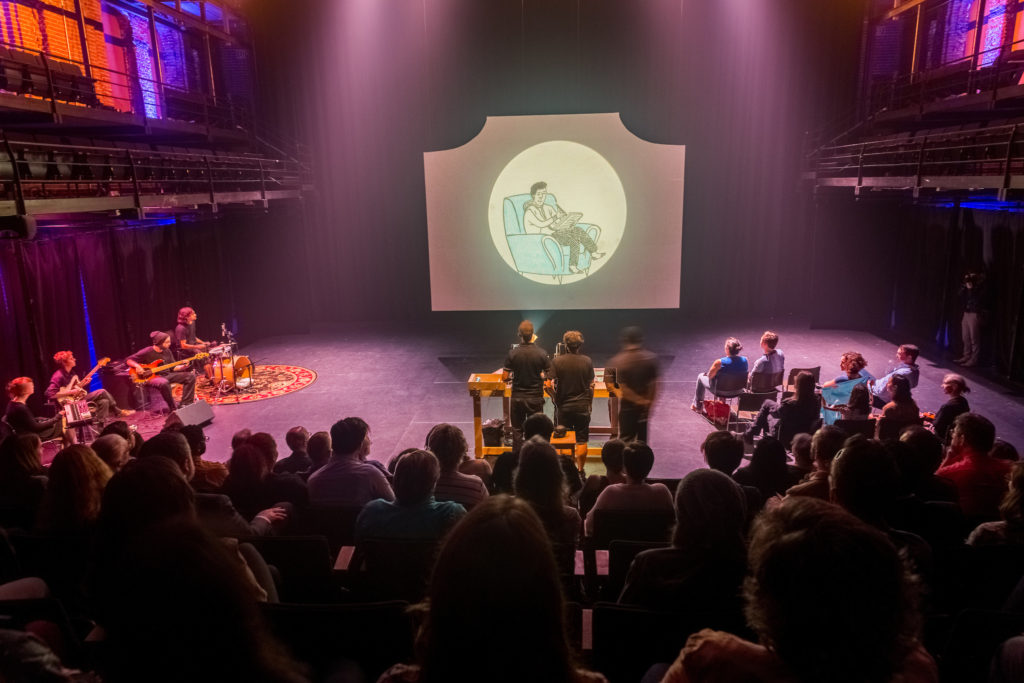
Despite a few missed opportunities to make this more of an immersive experience, Midnight in Molina was entertaining. With a fresh mix of the quotidian, the supernatural, and the hilarious—often with an edge of spontaneity—the plot was able to speak to heavy themes while avoiding turning into a slog. Much of that had to do with the mechanism of the crankie itself. And though storyline specifics, at times more riff than matured theme, eventually fade from memory, the novelty of the crankie and its riot of imagery, plus the joy of live storytelling, are its lasting legacies.
![]()
Cole Hoyer-Winfield and crew will be reprising their performance of Midnight in Molina on November 20 at Spirit in Lawrenceville.
The New Hazlett Theater’s 2016-17 CSA Series continues with the December 8, 2016 performance of Redemption Sons, by Dr. Tameka Cage Conley and Dr. Jason Mendez. Look out for our preview in the coming weeks. And sign up to become a member of the CSA here.
